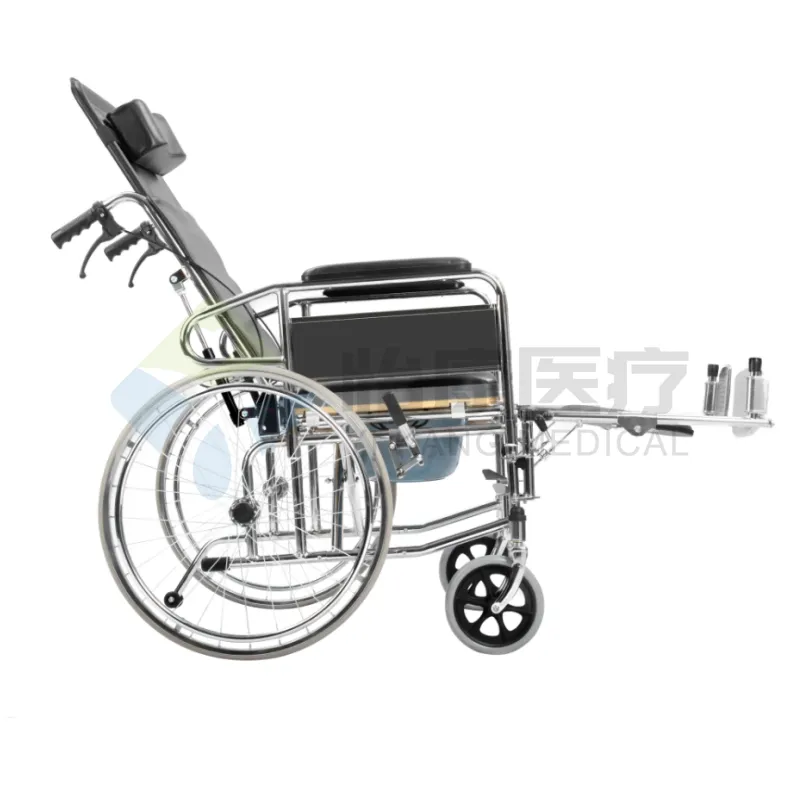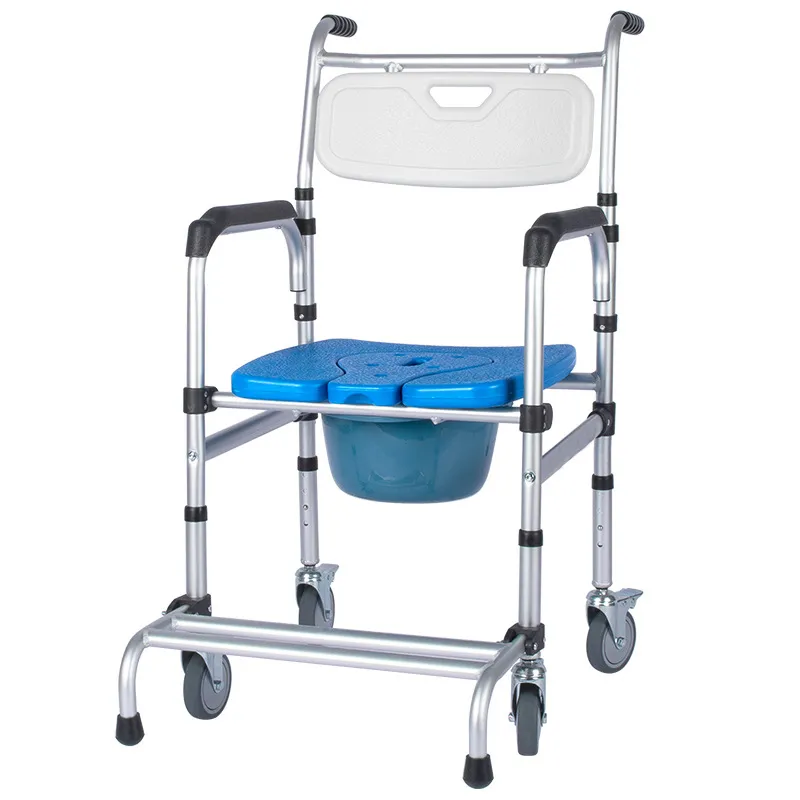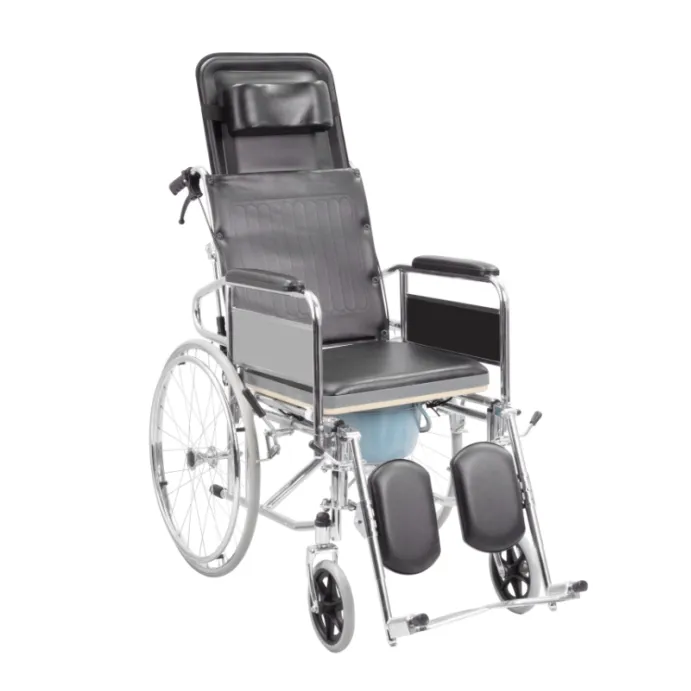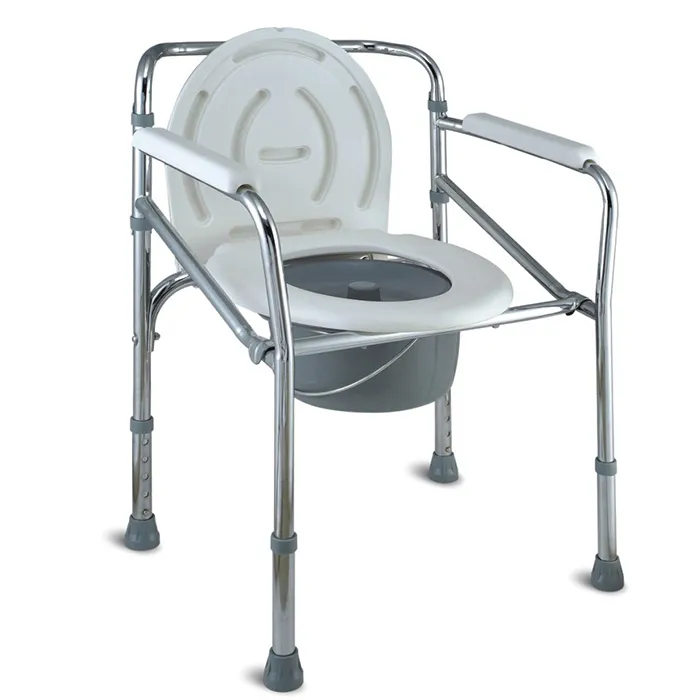In the field of nursing industry and rehabilitation assistive equipment, toilet wheelchair and toilet chair are two common assistive devices, which are widely used in the daily life of the elderly, people with limited mobility and rehabilitation patients. Although the names of the two are similar, many consumers often confuse them when purchasing and do not know the specific differences between the two.
In order to help the majority of caregivers, consumers and medical institutions better understand the characteristics and differences of these two devices, this article will provide a professional and detailed explanation from multiple aspects such as definition, functional structure, applicable population, usage scenarios, design details, etc., to fully answer the question "What is the difference between toilet wheelchair and toilet chair?"

What is a toilet wheelchair?
The toilet wheelchair, also known as a wheelchair with a potty, is a medical assistive device that has both mobility and toilet functions. The toilet wheelchair is not only equipped with a potty system, but also with wheels, and usually has a push ring or a large rear wheel, allowing the user or caregiver to push and move. This design allows people with limited mobility to not only use the toilet conveniently, but also to move short distances with their own strength or the help of others.
What is a toilet chair?
A toilet chair is a fixed potty chair designed to assist people with limited mobility to use the toilet at the bedside or other suitable locations. Toilet chairs usually have four supporting legs, and some models are equipped with small pulleys for short-distance movement, but the overall stability is the main focus. Most toilet chairs do not have the function of self-mobility and rely more on caregivers to move them.
In summary, the toilet wheelchair has both movement and toilet functions, while the toilet chair mainly assists with static toileting, which is the most fundamental difference between the two.

Toilet wheelchair VS. toilet chair: functional structure comparison
1. Mobility
● Toilet wheelchair: equipped with a large wheel or small wheel system, some products have a self-driving function, allowing users to push forward by themselves, suitable for daily short-distance autonomous movement and toileting needs.
● Toilet chair: Most toilet chairs have a four-legged structure with poor mobility. Only a few models are equipped with small casters for caregivers to push and move short distances.
2. Potty position
● Toilet wheelchair: The potty structure is usually designed under the seat, which is easy to disassemble and clean at any time, and the potty is firmly fixed, suitable for stability during movement.
● Toilet chair: The potty design is also located under the seat, but more attention is paid to the integrity of the potty and the seat structure, reducing the possibility of the potty sliding, and facilitating long-term bedridden patients to go to the toilet.
3. Load-bearing and stability
● Toilet wheelchair: Due to the need to ensure safety during movement, the design of the toilet wheelchair will strengthen the support structure in the axle, frame and other parts, and the load-bearing is generally between 100 kg and 150 kg.
● Toilet chair: The load-bearing design pays more attention to stable support. Most toilet chairs use thickened metal pipes or aluminum alloy structures, with similar or higher load-bearing standards, but the overall center of gravity is low and the mobility is poor.
Toilet wheelchair VS. toilet chair: Different applicable groups
To understand toilet wheelchairs and toilet chairs, it is also necessary to clarify the user groups they are suitable for.
1. Applicable groups of toilet wheelchair
● Patients who can push themselves or move short distances with help.
● People with limited lower limb strength but better upper limb strength, such as stroke recovery patients, amputees, etc.
● Elderly people or people with limited mobility who need to change rooms or beds frequently to go to the toilet.
2. Applicable groups of toilet chair
● Patients who are bedridden for a long time and have great difficulty in moving, such as severe stroke patients, patients with late Parkinson's disease, etc.
● Patients in the recovery period who are temporarily unable to move on their own and need to go to the toilet at the bedside or in a fixed position.
● High-risk patients who need highly stable support to prevent falls or overturning.
It can be seen that the design of toilet wheelchair is more inclined to mobile needs, while toilet chair focuses on stability and safety during the toilet process.

Toilet wheelchair VS. toilet chair: different usage scenarios
1. Usage scenarios of toilet wheelchair
● Hospital ward: Patients can use toilet wheelchair to go to the toilet independently or with the assistance of nursing staff.
● Home care: used for short-distance movement between different rooms and bathrooms for the elderly or disabled.
● Nursing homes and rehabilitation centers: suitable for users who need a certain degree of autonomy to improve their ability to take care of themselves.
2. Usage scenarios of toilet chair
● Home bedside care: provide convenience for bedridden patients to go to the toilet at night or daily.
● Hospital ICU and long-term care wards: long-term bedridden patients go to the toilet by the bed without frequent movement.
● Early stage of rehabilitation: provide toilet support before the patient has recovered basic mobility.
toilet wheelchair VS. toilet chair: different design details
1. Material selection
● Toilet wheelchairs are usually made of lightweight and high-strength aluminum alloy or stainless steel to ensure sufficient strength while maintaining light weight.
● Toilet chairs are mostly made of steel or reinforced plastic, which is heavier and more stable.
2. Seat design
● The seat of the toilet wheelchair is often padded, which is convenient for long-term sitting and lying, and is also equipped with anti-slip patterns to prevent slipping.
● The toilet chair seat is more stable and wide, which is convenient for patients to transfer up and down with the help of nursing staff.
3. Footrest and armrest
● The toilet wheelchair usually has a reversible or detachable footrest to facilitate getting on and off the vehicle, and some models are equipped with liftable armrests for lateral transfer.
● The toilet chair armrest design is more sturdy and immovable to ensure that the user gets maximum support when using the toilet.
4. Brake and safety lock
● The toilet wheelchair is equipped with a wheel brake system to ensure that there will be no accidents due to the wheelchair sliding when using the toilet.
● Since the toilet chair itself does not have a large range of movement function, it is generally not equipped with a complex brake system, but if it is equipped with small casters, it also has a locking function.

Toilet wheelchair VS. toilet chair: price difference
Generally speaking, the price of toilet wheelchair is generally higher than that of toilet chair because of its more complex structure and higher material requirements. The price of ordinary toilet chairs on the market ranges from a few hundred yuan to about a thousand yuan, while the price of toilet wheelchairs can range from more than a thousand yuan to tens of thousands of yuan depending on the functional configuration.
In addition, some toilet wheelchairs also integrate advanced functions such as electric drive and lifting seats, and the price has further increased. However, due to its single function, the price and maintenance cost of toilet chairs are relatively low, which is suitable for large-scale procurement and daily care use.
There is a significant difference between toilet wheelchairs and toilet chairs in essence.
The toilet wheelchair emphasizes the comprehensive function of "mobility + toileting", which is suitable for people with certain self-care ability but limited mobility.
The toilet chair emphasizes "stable toileting", which is more suitable for patients who have completely lost their mobility or are severely inconvenient to move.
Understanding and reasonably distinguishing between toilet wheelchairs and toilet chairs can not only help patients choose appropriate auxiliary equipment according to their own conditions, but also improve the efficiency of nursing work and the quality of life of patients.
Are your products compliant with safety regulations?
Yes, safety is a key focus at Yikang Medical. All our products are manufactured in accordance with the highest safety standards. Our hospital beds, wheelchairs, and rehabilitation equipment comply with international regulations, including CE, FDA, and ISO13485 certifications. By choosing Yikang Medical, you can be assured that you are purchasing safe, reliable, and high-quality products for your healthcare needs.

